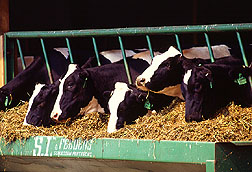This page has been archived and is being provided for reference purposes only. The page is no longer being updated, and therefore, links on the page may be invalid.
Organic Dairy Manure May Offer Fertilizer Option
By Ann PerryApril 22, 2009
Dairy cows that produce USDA-certified organic milk also produce manure that may gradually replenish soil nutrients and potentially reduce the flow of agricultural pollutants to nearby water sources, according to findings by Agricultural Research Service (ARS) scientists and colleagues.
Cows on organic dairy farms generally consume forage feeds cultivated on soils that are fertilized with manure and compost rather than manufactured fertilizers. This organic management, in turn, may significantly affect how easily nutrients are converted in soil into forms readily taken up by crops.
Working with colleagues at the ARS New England Plant, Soil, and Water Laboratory in Orono, Maine, and elsewhere, chemist Zhongqi He showed that conventional and organic dairy manures from commercial dairy farms differed in concentrations of plant nutrients, including phosphorus, metals and minerals.
The team used two different types of nuclear magnetic resonance (NMR) to pinpoint these differences. Solution NMR spectroscopy is already widely used to analyze phosphorus content in manure. For this study, the scientists also analyzed manure content using solid-state NMR spectroscopy, which is especially effective at finding unique “signatures” of the different kinds of metals and minerals.
The researchers found that the two types of manure had at least 17 different chemical forms of phosphorus that varied in concentrations. The organic dairy manure had higher levels of phosphorus, calcium, potassium, manganese, zinc and magnesium.
Organic dairy manure also contained more types of phosphorus found in association with calcium and magnesium. Such forms are comparatively slow to dissolve and would thus gradually release the nutrients. Slow-release fertilizers generally increase the likelihood that they eventually will be taken up by crops, rather than being washed out of fields into nearby surface or groundwater sources.
Because of this, slow-release fertilizers often can be applied at comparatively low rates. Manure produced by cows in organic production systems may show similar characteristics compared to manure from conventional systems.
ARS is the principal intramural scientific research agency of the U.S. Department of Agriculture.

